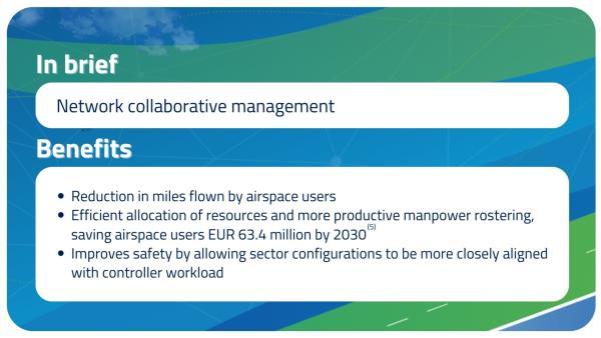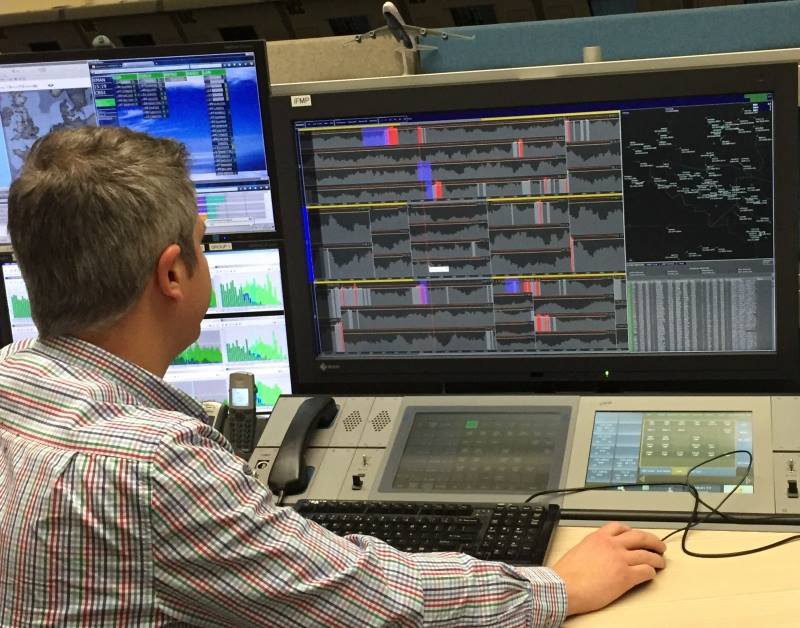Balancing demand and capacity starts with integrated information
By integrating information coming from multiple sources, SESAR is helping to increase predictability, decrease delays and enhance safety.
With passenger demand on the rise and traffic flows being increasingly disrupted by extreme weather and geopolitical events, assessing airspace demand is becoming even more challenging. SESAR is addressing this head on with Solutions that can assess traffic demand and complexity based on continuously updated information from multiple sources.

Seamless flights require close collaboration between airports, airlines and air traffic control. For instance, air traffic control uses flight plan data, filed by airlines, to safely and efficiently manage the airspace.
Yet despite this collaboration, flights still experience unexpected disruptions, the result of severe weather, airspace congestion or unplanned events that alter the actual trajectory flown. When this happens, air navigation service providers (ANSPs) adjust capacity by opening and closing sectors. By absorbing daily peaks, these measures help mitigate capacity shortfalls.
The glue that binds these components together is access to up-to-date and accurate information. For example, when ANSPs have access to the right information, they can anticipate traffic complexity and potential overload situations and take timely action to manage resources more efficiently.
But with passenger demand on the rise and traffic flows being increasingly disrupted by extreme weather and geopolitical events, today’s non-integrated tools are no longer able to provide the information stakeholders need to efficiently balance demand and capacity. What they need is access to integrated, accurate and timely data coming from multiple sources, including planned trajectory information, surveillance data, network information, local aspects, weather forecasts and recorded analytical data.
An advanced software programme delivered by SESAR provides such access.
By enabling the timely exchange of trajectory information, the software delivers pertinent information derived from multiple sources, allowing stakeholders to anticipate potentially disruptive events, allocate the necessary resources and thus improve network performance.
The net result is more predictable traffic flows, fewer delays and enhanced safety.
The solution
SESAR developed digital tools that enable stakeholders to exchange data in a cyber-secure environment. Together with its industry partners, SESAR is also co-funding the deployment of these tools at operational sites around Europe.
The results
SESAR traffic complexity assessment and resolution tools provide local flow management positions (FMP) with more accurate information about traffic flow, predict complexity and anticipate traffic peaks (SESAR Solution #19(1)).
The details
- SESAR implementation programmes increase coordination and improve flight efficiency, safety and capacity through the exchange, modification and management of trajectory information.
- Network collaborative management helps create common situational awareness that benefits local interests and the wider network operations plan (the platform that optimises and synchronises planning at the network level).
- Extended flight plan data enriched with detailed trajectory and flight performance information (SESAR Solution #PJ18-02C (2)) lessens the need to apply air traffic flow management regulations during busy periods, improves traffic predictability and facilitates the assessment of traffic complexity.
- When combined with such SESAR resource management tools as advanced short air traffic flow and capacity management (ATFCM) measures (SESAR Solution #17 STAMs (3)), the solution helps identify the optimal strategy for protecting airspace capacity with the least penalty for users.
- The technology is included in Europe’s Common Project 1 (CP1) Regulation, which aims to drive network efficiency through increased data exchange via system-wide information management (SWIM).
In action
Pioneer ANSPs have already started deploying automated data updates from local and network sources to integrate real-time flight data, meteorological forecasts, military airspace requirements and other data – providing the FMP with a qualitative perspective on traffic demand.
For example, in Bulgaria (where traffic complexity is especially high due to geopolitical unrest in nearby states, the opening of a new airport in Istanbul and seasonal summer traffic hikes), Bulatsa introduced a traffic complexity assessment tool (SESAR AF4 2015-217(4)) that reduced sector manpower hours by 2.5% and returned investment within two years(5).
Meanwhile, in Belgium, skeyes simulated integrating relevant data with a traffic complexity assessment and simulation tool before implementing procedures to deploy as part of the ATFCM process at the Brussels area control centre (SESAR AF4 2017-062(6)).
At the Network Management level, airline operations centres and computerised flight plan service providers (CFSPs) have deployed SESAR procedures to exchange target arrival times, in addition to calculated arrival time, to all concerned users (SESAR AF4 2015-114(7)). For instance, Sabre flight planning systems in Austria, France and Poland access planned 4D trajectory data and flight performance data to improve collaborative flight planning.
The result is more accurate pre-departure flight planning through the upgrade of interfaces with EUROCONTROL Network Manager stakeholders (SESAR AF4 2015-106(8)), in line with ICAO provisions for flight and flow information for a collaborative environment (FF-ICE).
The collaborative process builds on earlier SESAR research on balancing demand and capacity (SESAR Solution #18(9)).


Réferences
- SESAR Solution #19: Automated support for traffic complexity detection and resolution
- This solution has already been implemented in Azerbaijan, Bulgaria, Georgia, Latvia, Maastricht UAC, Malta, Poland, Switzerland, Turkey.
- SESAR Solution #17/Release 5: Advanced short-term ATFCM measures
- SESAR AF4: tCAT implementation in Sofia ACC
- SESAR AF4: Bulatsa completes SESAR deployment implementation project tCAT (Alternative reference)
- AF4: Traffic complexity assessment and simulations tool (TCAST)
- AF4: Implementation of target times for ATFCM purposes (NM)
- AF4: Flight evolution and upgrade of interfaces with NM stakeholders
- SESAR Solution #18: Calculated take-off time (CTOT) and target time of arrival (TTA)

